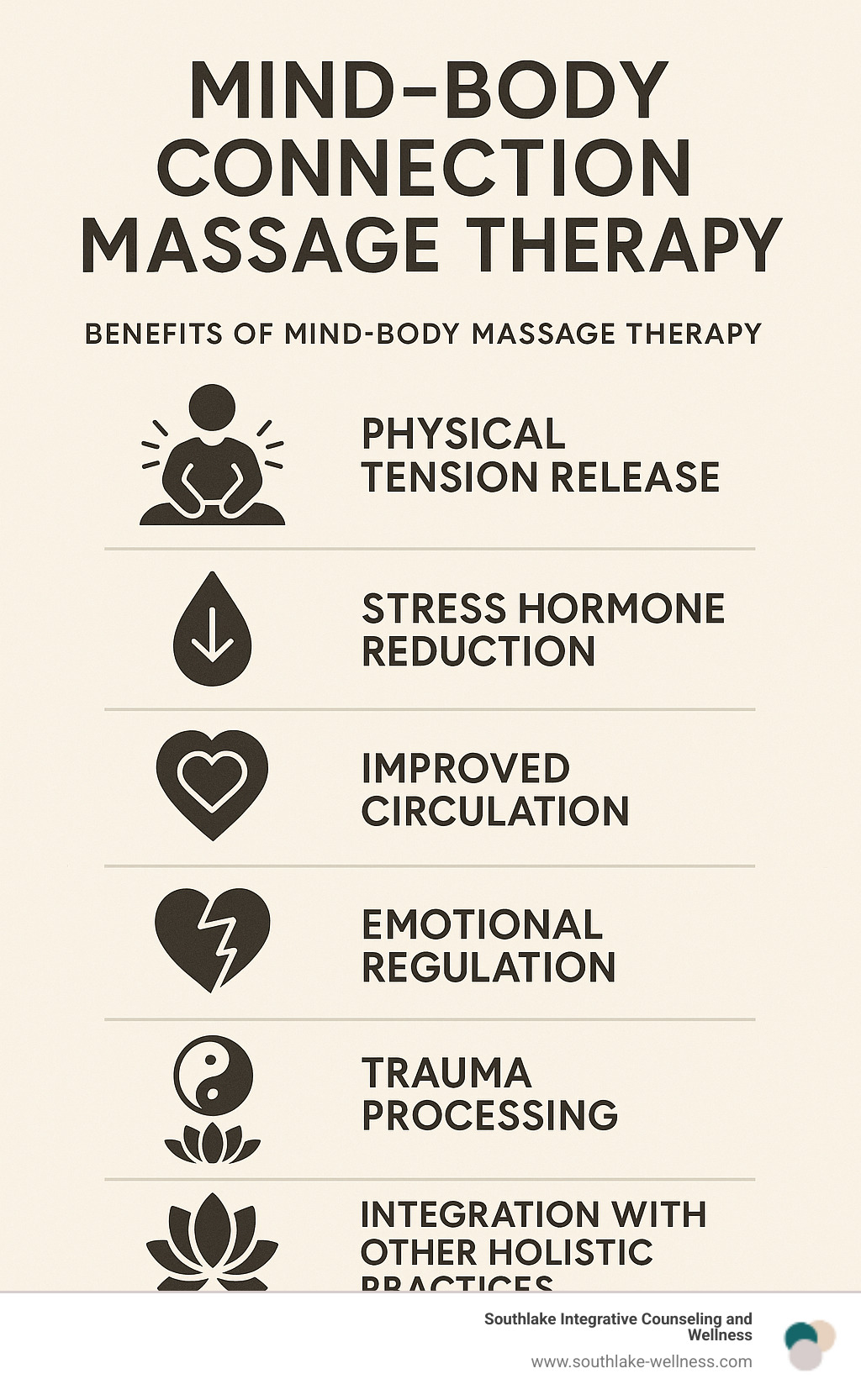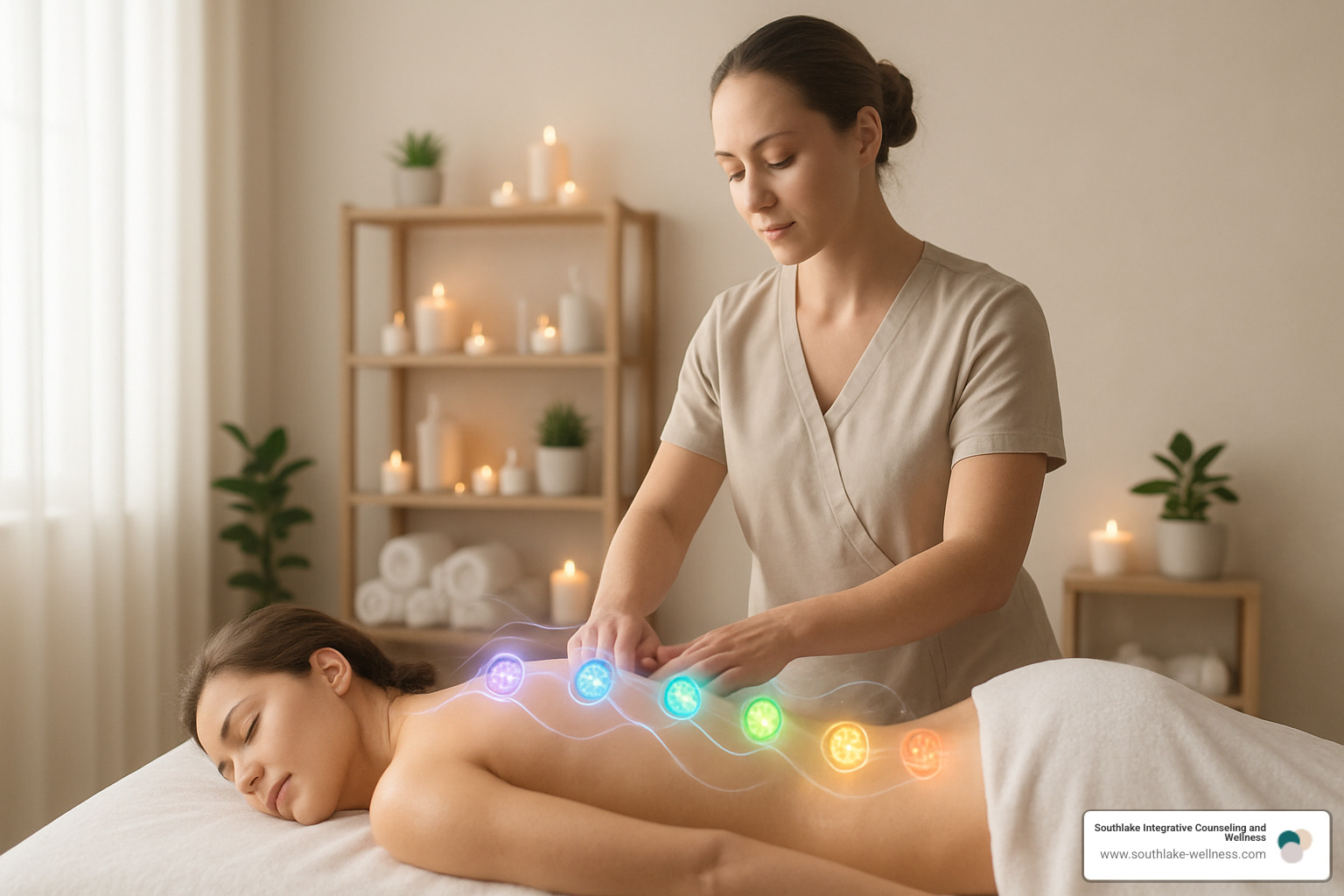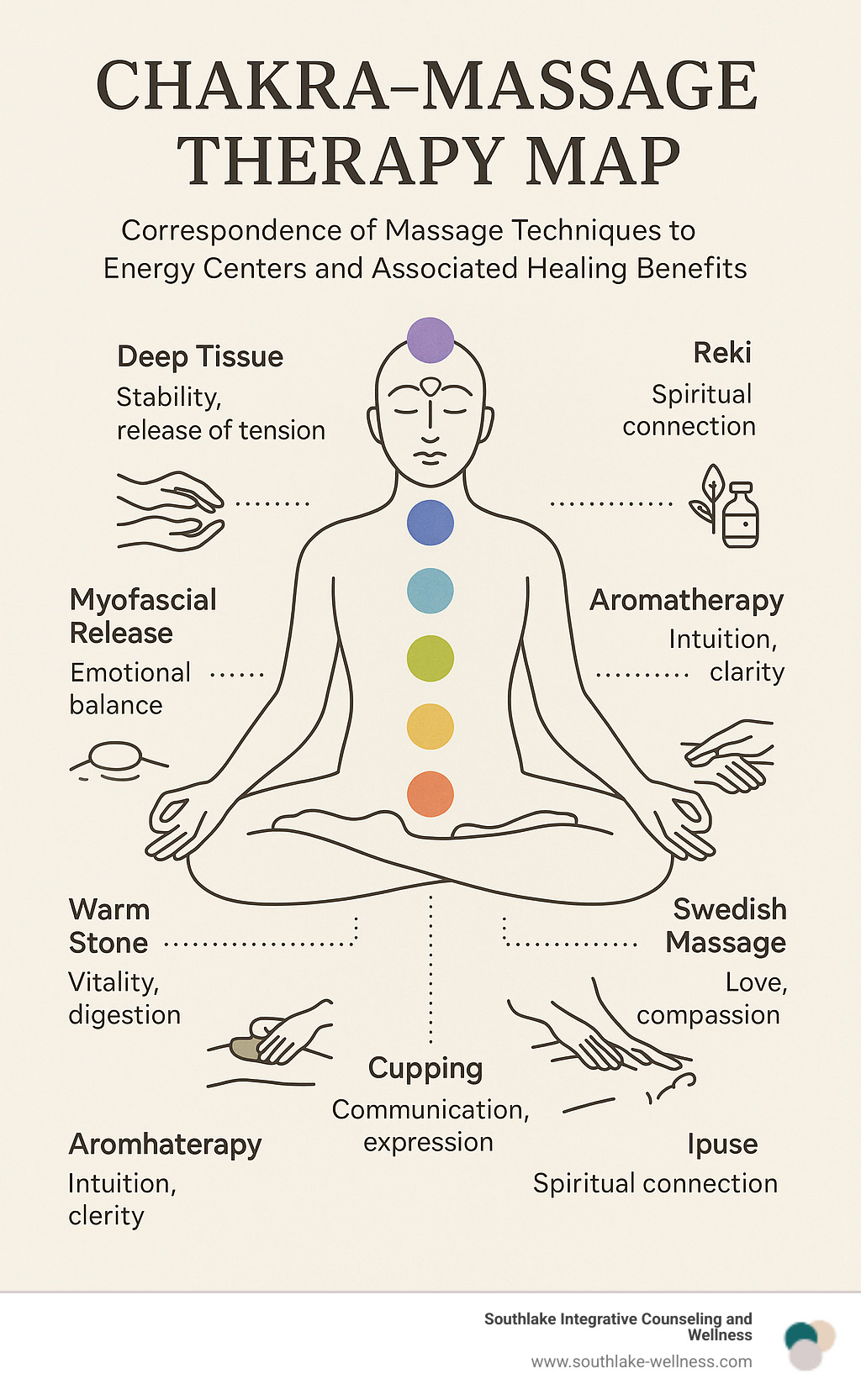
Why Mind Body Connection Massage Therapy Works Where Other Treatments Fall Short
Mind body connection massage therapy blends proven manual techniques with mindful awareness so you can release physical tension and emotional stress in the same session. Instead of treating muscles and moods separately, it works with the way your thoughts, feelings, and tissues continually affect one another.
What This Approach Addresses
- Physical: Muscle tension, chronic pain, headaches, circulation issues
- Mental: Anxiety, racing thoughts, poor concentration, mental fatigue
- Emotional: Stress, overwhelm, numbness, trauma responses
Research shows massage boosts feel-good hormones like dopamine and serotonin while lowering stress hormone cortisol, improving blood pressure, sleep, and even addiction recovery outcomes. The added breathwork, mindfulness, and energy awareness turn ordinary bodywork into a whole-person reset.
I'm Holly Gedwed, a Licensed Professional Counselor Associate with 14 years in trauma and addiction recovery, and I’ve seen this therapy help clients process emotions locked deep in their muscles when talk therapy alone wasn’t enough.

Simple guide to mind body connection massage therapy:- mind-body wellness therapy- holistic approach to depression- integrative mental health services
The Science Behind the Mind–Body Connection
Your mind and body aren't separate entities - they're constantly communicating through an intricate network that scientists are just beginning to fully understand. The star of this communication system is your vagus nerve, a superhighway that connects your brain to your heart, lungs, digestive system, and other vital organs.
This fascinating field of study, called psychoneuroimmunology, explores how your thoughts and emotions directly influence your nervous and immune systems. When you're stressed about a work deadline, your brain doesn't just worry - it sends chemical messengers throughout your body, releasing cortisol and dopamine while affecting serotonin levels.
Here's the beautiful part: this connection works both ways. Just as mental stress creates physical symptoms, physical healing can calm emotional turmoil. Scientific research on the mind-body link confirms what holistic practitioners have known for centuries - therapeutic touch can literally rewire how we respond to stress.
This is exactly why mind body connection massage therapy works so effectively. It addresses both sides of the conversation happening between your mind and body.
Stress in the Body: From Thought to Tight Muscle
Picture this: you're lying in bed at 2 AM, mind racing about tomorrow's presentation. Within seconds, your brain perceives this as a threat and triggers a cortisol surge. Your muscles respond by tensing up - a protective mechanism called muscle guarding.
This tension restricts oxygen flow to your tissues, creating that familiar ache in your neck and shoulders. But here's where it gets tricky: this physical discomfort sends signals back to your brain, confirming that something's wrong. You've just created a pain cycle that can persist long after the presentation is over.
We see this pattern constantly at our practice. A client comes in with chronic headaches, and during our session, we find they started during a difficult divorce two years ago. The body literally held onto that emotional stress, even after life settled down.
This is where holistic stress management techniques become essential. Traditional approaches might treat the headache or the stress separately, but integrated therapies address the whole picture.
Hormones & Touch: Why Massage Changes Brain Chemistry
Here's something amazing: the moment skilled hands begin therapeutic work, your body starts producing endorphins - natural painkillers that are actually more powerful than morphine. But the hormonal party doesn't stop there.
Therapeutic touch also releases oxytocin, often called the "bonding hormone," which creates feelings of connection and trust. Your parasympathetic nervous system kicks in, switching you from "fight-or-flight" mode to "rest-and-digest" mode. Many clients experience a noticeable blood pressure drop within the first few minutes of their session.
The research is compelling. Studies show that regular massage therapy not only promotes immediate relaxation but creates lasting changes in how our bodies handle stress. This biochemical shift is what makes mind body connection massage therapy so much more than just muscle manipulation - it's a complete reset for your entire nervous system.
What Is Mind Body Connection Massage Therapy?

Imagine lying on a massage table, but instead of just feeling hands working on your muscles, you sense something deeper happening. Mind body connection massage therapy creates this experience by weaving together therapeutic touch with mindful awareness of your complete being - body, mind, and spirit.
This isn't your typical spa massage. While the practitioner might use familiar Swedish strokes or deep tissue techniques, they're also tuned into your biofield - the subtle energy that surrounds your body. They notice how your breathing changes, where you hold tension, and how different areas of your body respond to touch.
The magic lies in the intentional pressure combined with mindfulness. Your therapist might guide you through breathwork, helping you stay present with whatever sensations or emotions arise. It's massage with purpose - addressing not just the knot in your shoulder, but the stress pattern that created it in the first place.
How Mind Body Connection Massage Therapy Alleviates Stress
When stress lives in your body, it needs more than just physical manipulation to release. Mind body connection massage therapy works like a gentle conversation between your therapist's hands and your nervous system.
As skilled touch begins muscle relaxation, something beautiful happens in your brain. Your limbic system - the emotional control center - starts receiving signals that say "you're safe now." The practitioner often incorporates guided breathing techniques, helping shift you from fight-or-flight mode into deep rest and repair.
During sessions, don't be surprised if emotions surface. You might find yourself sighing deeply, feeling unexpectedly tearful, or even laughing. This limbic calming process is your body's way of releasing stress that's been stored in your tissues.
Mind Body Connection Massage Therapy vs. Other Holistic Practices
Mind body connection massage therapy shares some common ground with other healing approaches, but each offers its own special gifts. While Reiki focuses primarily on energy healing through light touch, mind-body massage combines that energetic awareness with deeper physical manipulation.
The Reiki blend aspect means your therapist might pause during the session to simply hold space over areas that feel energetically blocked. Aromatherapy fusion often improves the experience - essential oils chosen not just for their scent, but for how they support your emotional release and nervous system regulation.
Movement therapies like yoga or tai chi work beautifully alongside this type of massage. Where movement helps you build awareness of your body in action, mind-body massage helps you understand what your body holds when it's still.
The real power emerges when these modalities dance together. At our practice, we've seen clients make breakthrough progress when they combine massage sessions with other holistic approaches, creating a comprehensive support system for both healing and growth.
Proven Benefits & Supporting Evidence
When clients ask about the research behind mind body connection massage therapy, the data is compelling. Scientific research on massage outcomes confirms gains that extend well beyond a moment of relaxation.
In practice, we regularly witness lasting improvements in pain relief, mental clarity, cardiovascular markers, immune response, sleep quality, and trauma recovery—findings mirrored by peer-reviewed studies.
Physical Gains Backed by Studies
Regular massage lowers blood pressure, improves circulation, and eases fascial restrictions so muscles move freely again. Clients with chronic pain often reduce or even eliminate certain medications after consistent sessions.
Mental & Emotional Upsides
Therapeutic touch decreases cortisol while boosting serotonin and dopamine, effectively rewiring the stress response. This calms anxiety, supports depression treatment, and, in addiction recovery, reduces cravings by settling the nervous system. For trauma survivors, bodywork offers a safe pathway to release memories stored in muscle tissue.
Techniques & Modalities That Foster Mind–Body Balance

Mind body connection massage therapy draws from a rich toolbox of techniques, and the best practitioners know how to blend them seamlessly. Each modality brings something unique to the healing table.
Swedish massage forms the foundation with its long, flowing strokes that help your nervous system downshift into relaxation mode. When we need to go deeper, deep tissue work targets those stubborn knots and adhesions. Warm stone therapy takes relaxation to another level - the heat actually helps muscles release more completely than hands alone.
For fascial restrictions - those sticky, web-like tissues that can trap tension - myofascial release uses gentle, sustained pressure that feels almost like melting. Chakra balancing brings energy work into the mix, focusing on the body's seven main energy centers. Reiki integration adds another layer of healing through light touch and energy awareness. Aromatherapy fusion engages your sense of smell to calm anxiety or boost mood.
Energy Work, Chakras & Flow
Many practitioners have found that physical tension often has an energetic component. That chronic shoulder pain might be related to feeling like you're carrying the weight of the world. Lower back issues could connect to feeling unsupported in life.
The root chakra at the base of your spine relates to feeling grounded and safe. When it's blocked, you might notice hip tension or lower back pain. The heart chakra in your chest can hold grief, relationship stress, or even joy that you haven't fully let yourself feel.
Essential oils can amplify this work beautifully. Sandalwood helps with grounding when you feel scattered. Lavender soothes anxiety. Peppermint can clear mental fog. Rose opens the heart to healing. The scents work directly on your limbic system - the emotional center of your brain - while the massage addresses physical tension.

Strengthen Your Mind-Body Connection
Improve physical and mental well-being with our specialized massage therapy sessions in Southlake.
Explore Yoga & Massage
Integrating Massage with Reiki & Aromatherapy
The magic happens when these modalities work together instead of separately. Imagine getting a Swedish massage while your therapist also channels Reiki energy and diffuses calming lavender. Your muscles relax from the physical touch, your energy field balances through Reiki, and your nervous system calms through aromatherapy.
It's not about doing more for the sake of more - it's about creating the right combination for your unique needs. Some sessions might focus heavily on deep tissue work with just a touch of aromatherapy. Others might blend gentle Swedish strokes with significant energy work.
Our mind-body wellness therapy approach recognizes that healing rarely happens in neat, separate boxes. Your body, mind, emotions, and spirit are all connected. When we honor that connection through integrated mind body connection massage therapy, the results can be truly transformative.
Getting the Most from Your Sessions

Think of mind body connection massage therapy like tending a garden - the more thoughtful preparation you put in, the more beautiful the results. Your session begins the moment you decide to book, not when you arrive at the appointment.
Start by being completely honest on your intake forms. Yes, it might feel awkward to mention that weird shoulder thing or the anxiety that keeps you up at night, but this information helps your therapist understand the full picture. Your body tells a story, and we need all the chapters to help you heal effectively.
Hydration is your friend - drink plenty of water before your session, but skip that large lunch right beforehand. Your body does its best healing work when it's not busy digesting a heavy meal.
Setting an intention can transform your experience from "nice relaxation time" to "powerful healing session." Maybe you want to release stress from your shoulders, process some difficult emotions, or simply reconnect with your body after a challenging period. Whatever it is, let your therapist know.
What to Expect During a Session
Your first session starts with a real conversation, not just a quick health form check. We want to understand what brought you here - is it the physical pain, the emotional overwhelm, or that nagging feeling that something just isn't quite right?
The massage itself happens in a quiet, comfortable space where you can truly let your guard down. Professional draping ensures your modesty while allowing access to the areas that need attention. Your therapist will regularly check in about pressure - never suffer through discomfort thinking you're supposed to "tough it out."
Here's something many people don't expect: emotions might surface during your session. You might find yourself tearing up when we work on your neck, or feeling unexpectedly angry when we address that chronic hip tension. This is completely normal and actually a sign that the therapy is working on deeper levels than just the physical.
Who Can Benefit & How Often to Book
Athletes often find that regular sessions don't just help them recover faster - they actually perform better because their bodies learn to release tension before it becomes injury. Seniors find that therapeutic touch provides not just physical relief, but meaningful human connection that improves overall wellbeing.
Children (with parental consent) respond beautifully to gentle massage, especially when they're dealing with school stress or big life changes. Prenatal clients often tell us it's the first time during pregnancy they've felt truly comfortable and supported.
For those dealing with chronic pain, mind body connection massage therapy offers a path forward that doesn't rely solely on medications. Trauma survivors frequently find that bodywork helps them reconnect with their physical selves in safe, healing ways.
As for frequency, think of it like exercise - consistency matters more than intensity. Monthly sessions work well for general stress management and maintenance. If you're dealing with chronic pain or working through trauma, weekly sessions initially can provide the momentum needed for lasting change.
Risks & Contraindications to Know
While mind body connection massage therapy is incredibly safe for most people, there are times when we need to pause or modify our approach. If you have blood clots, recent fractures, severe osteoporosis, recent surgery, or active cancer, we'll need clearance from your healthcare provider first.
Recent heart attacks, serious heart conditions, or acute illness also require medical approval. A good therapist will always err on the side of caution when it comes to your safety.
Finding a Qualified Mind–Body Massage Therapist
The best massage therapist for you is someone who combines technical skill with genuine care. Look for current state licensure and continuing education in mind-body techniques. Training in energy work, trauma-informed care, or specialized modalities shows commitment to this integrated approach.
Good communication skills matter enormously - you want someone who listens carefully and explains what they're doing. Professional boundaries are equally important; you should always feel safe and respected.
At Southlake Integrative Counseling and Wellness, our approach naturally emphasizes the mind-body connection through integrative mental health services. We work closely with qualified massage therapists who understand how bodywork beautifully complements traditional therapy, creating a complete support system for your healing journey.
Book Your Mind-Body Therapy Session
Speak to our Southlake wellness specialists to restore harmony and relaxation. Contact Us now.
Frequently Asked Questions about Mind Body Connection Massage Therapy
These are the questions we hear most often from clients considering mind body connection massage therapy. Let me share what I've learned from years of helping people steer this healing journey.
Does insurance cover mind body connection massage therapy?
The insurance landscape for massage therapy can feel like a maze, but here's what you need to know. Coverage varies dramatically between providers and plans. Some health insurance plans will cover massage therapy - but usually only when it's prescribed by a physician for specific medical conditions like chronic pain, injury recovery, or certain musculoskeletal disorders.
The good news? Many Health Savings Accounts (HSAs) and Flexible Spending Accounts (FSAs) can be used for therapeutic massage. This gives you more control over using your healthcare dollars for treatments that actually help you feel better.
My advice? Call your insurance provider directly and ask about massage therapy coverage. Some plans require pre-authorization or a physician's referral, so it's worth checking before your first session. Even if insurance doesn't cover it, many clients find the investment in their wellbeing pays dividends in reduced medical costs and improved quality of life.
How soon will I feel results from mind body connection massage therapy?
This is probably our most common question, and I love answering it because the results can be so immediate and profound. Many clients notice changes right on the massage table - their breathing deepens, shoulders drop, and that tight feeling in their chest starts to ease.
Immediate effects you might experience include reduced muscle tension, improved mood, and better sleep that very night. I've had clients tell me they slept better after their first session than they had in months.
But here's where it gets really interesting: lasting changes typically develop over multiple sessions. For chronic conditions or trauma recovery, we usually see significant improvements after 4-6 regular sessions. Think of it like physical therapy for your nervous system - each session builds on the last.
The cumulative effects are where the real magic happens. While one session provides relief, regular mind body connection massage therapy creates lasting changes in how your nervous system responds to stress and how your body holds tension. It's like teaching your body a new way of being in the world.
Can mind body connection massage therapy be combined with talk therapy?
This question makes my heart sing because the answer is a resounding yes! In fact, I strongly encourage this combination. As a Licensed Professional Counselor Associate, I've seen how beautifully mind body connection massage therapy complements traditional counseling.
Here's why they work so well together: Talk therapy helps you process thoughts and emotions cognitively - understanding patterns, gaining insights, developing coping strategies. But trauma and stress don't just live in your mind; they're stored in your body too. Massage therapy helps release those patterns that are literally held in your muscles and tissues.
Many of our clients find that massage therapy actually improves their progress in counseling. When you feel more grounded and connected to your body, it's easier to do the emotional processing work that happens in therapy sessions. You might find yourself accessing feelings or memories during massage that you can then explore further in counseling.
At Southlake Integrative Counseling and Wellness, we understand this mind-body connection intimately. We work collaboratively with qualified massage therapists who understand how bodywork supports the therapeutic process. It's not just about treating symptoms - it's about healing the whole person.
Conclusion
Taking care of yourself isn't selfish - it's essential. Mind body connection massage therapy offers a beautiful way to honor both your physical and emotional needs in one healing experience.
Throughout this journey together, we've explored how your thoughts literally shape your body, how stress gets trapped in your muscles, and how the right kind of touch can release years of tension you didn't even know you were carrying. The science backs what many of us intuitively know: we can't separate our minds from our bodies when it comes to true healing.
What makes mind body connection massage therapy so powerful is its ability to work on multiple levels at once. While your muscles are relaxing under skilled hands, your nervous system is learning it's safe to let go. While essential oils calm your mind, energy work helps release emotional blockages. It's holistic self-care at its finest.
The research shows us that regular massage therapy doesn't just feel good - it actually changes your brain chemistry, lowers your blood pressure, and strengthens your immune system. When you add mindful awareness and complementary modalities like Reiki or aromatherapy, you're giving yourself a comprehensive tune-up that addresses stress at its roots.
At Southlake Integrative Counseling and Wellness, we've seen how powerful it can be when people accept this mind-body approach to wellness. Whether you're dealing with chronic pain that has an emotional component, recovering from trauma, or simply want to manage stress more effectively, this type of therapy can become a cornerstone of your ongoing support system.
Your body is constantly communicating with you through tension, pain, fatigue, and energy levels. Mind body connection massage therapy helps you listen to those messages and respond with compassion rather than frustration.
The beautiful thing about this approach is that it doesn't require you to choose between addressing physical symptoms or emotional ones. You get to work on both simultaneously, creating lasting changes that support your overall resilience and well-being.
Ready to experience what it feels like when your mind and body work together instead of against each other? We'd love to help you explore how this holistic approach might fit into your wellness journey. Learn more about our comprehensive services and find the supportive, integrative care that honors every aspect of who you are.